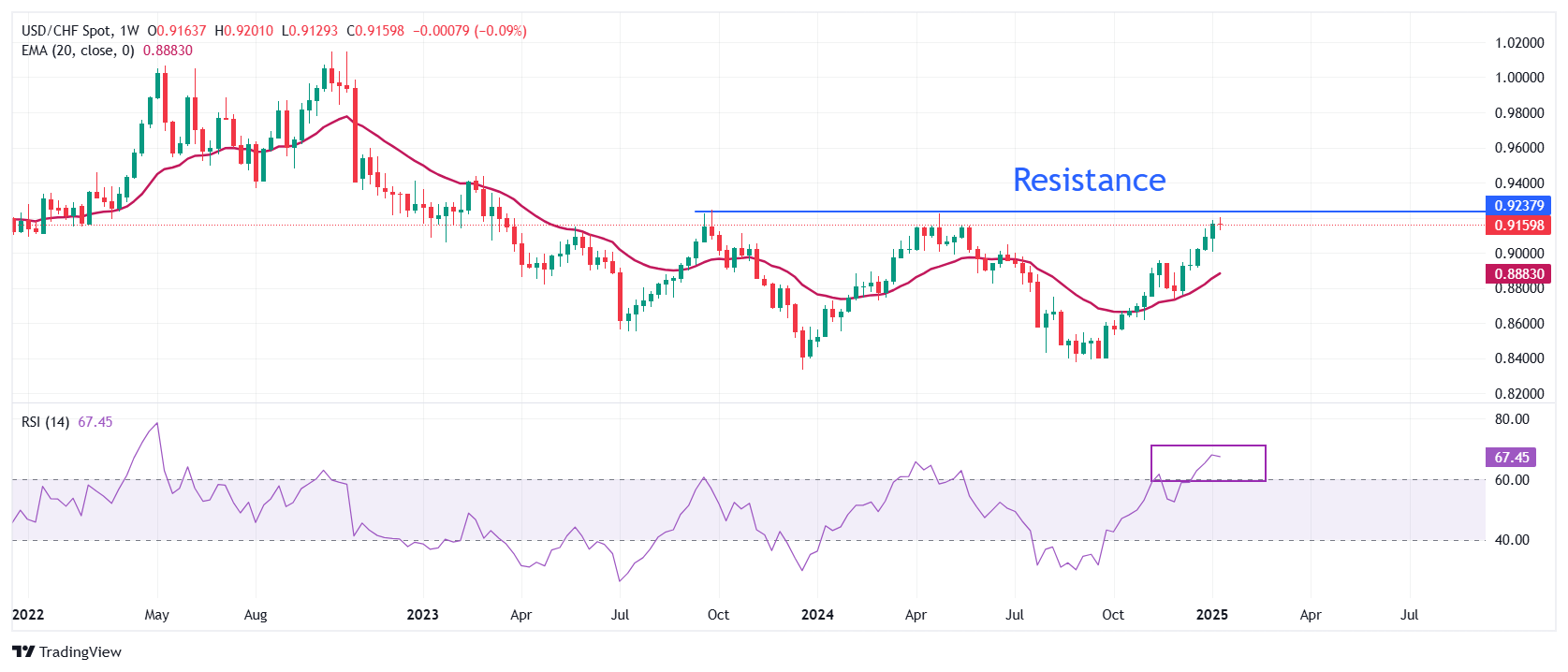USD/CHF Price Forecast: Needs to break above 0.9250 for fresh upside
- USD/CHF recovers intraday losses as the outlook of the US Dollar remains firm.
- Investors await the US inflation data as it will influence the Fed’s interest rate outlook.
- The SNB is expected to cut interest rates further to fuel inflationary pressures.
The USD/CHF pair recovers its intraday losses and flattens to near 0.9160 in Tuesday’s European session. The Swiss Franc pair bounces back as investors turn cautious ahead of the United States (US) Consumer Price Index (CPI) data for December, which will be released on December.
Investors will pay close attention to US inflation data, which will influence market speculation about the Federal Reserve’s (Fed) interest rate outlook. Year-on-year headline inflation is expected to have accelerated to 2.8% from 2.7% in November, with core readings growing steadily by 3.3%.
According to the CME FedWatch tool, traders roughly price in a 69% chance that the central bank will reduce interest rates once this year.
Meanwhile, the Swiss Franc (CHF) has been underperforming against the US dollar for the past few months. The Swiss National Bank (SNB) is expected to continue reducing interest rates further to boost inflationary pressures. The SNB has already reduced its key borrowing rates to 0.5%.
USD/CHF trades close to its 15-month high around 0.9200. The outlook of the Swiss Franc pair remains firm as the 20-week Exponential Moving Average (EMA) near 0.8883 is sloping higher.
The 14-week Relative Strength Index (RSI) oscillates in the bullish range of 60.00-80.00, suggesting a strong upside momentum.
For a fresh upside toward the round-level resistance of 0.9300 and the 16 March 2023 high of 0.9342, the asset needs to break decisively above the October 2023 high of 0.9244.
On the flip side, a downside move below the psychological support of 0.9000 would drag the asset towards the November 22 high of 0.8958, followed by the December 16 low of 0.8900.
USD/CHF weekly chart

US Dollar FAQs
The US Dollar (USD) is the official currency of the United States of America, and the ‘de facto’ currency of a significant number of other countries where it is found in circulation alongside local notes. It is the most heavily traded currency in the world, accounting for over 88% of all global foreign exchange turnover, or an average of $6.6 trillion in transactions per day, according to data from 2022. Following the second world war, the USD took over from the British Pound as the world’s reserve currency. For most of its history, the US Dollar was backed by Gold, until the Bretton Woods Agreement in 1971 when the Gold Standard went away.
The most important single factor impacting on the value of the US Dollar is monetary policy, which is shaped by the Federal Reserve (Fed). The Fed has two mandates: to achieve price stability (control inflation) and foster full employment. Its primary tool to achieve these two goals is by adjusting interest rates. When prices are rising too quickly and inflation is above the Fed’s 2% target, the Fed will raise rates, which helps the USD value. When inflation falls below 2% or the Unemployment Rate is too high, the Fed may lower interest rates, which weighs on the Greenback.
In extreme situations, the Federal Reserve can also print more Dollars and enact quantitative easing (QE). QE is the process by which the Fed substantially increases the flow of credit in a stuck financial system. It is a non-standard policy measure used when credit has dried up because banks will not lend to each other (out of the fear of counterparty default). It is a last resort when simply lowering interest rates is unlikely to achieve the necessary result. It was the Fed’s weapon of choice to combat the credit crunch that occurred during the Great Financial Crisis in 2008. It involves the Fed printing more Dollars and using them to buy US government bonds predominantly from financial institutions. QE usually leads to a weaker US Dollar.
Quantitative tightening (QT) is the reverse process whereby the Federal Reserve stops buying bonds from financial institutions and does not reinvest the principal from the bonds it holds maturing in new purchases. It is usually positive for the US Dollar.

